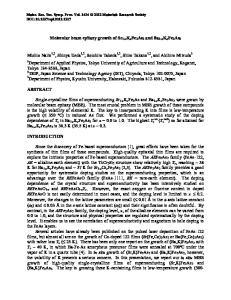Selective Radionuclide (Cs + , Sr 2+ , and Ni 2+ ) Ion-Exchange by K 2x Mg x Sn 3-x S 6 (x=0.5-0.95) (KMS-2)
- PDF / 1,325,221 Bytes
- 6 Pages / 612 x 792 pts (letter) Page_size
- 41 Downloads / 326 Views
1265-AA02-01
Selective Radionuclide (Cs+, Sr2+, and Ni2+) Ion-Exchange by K2xMgxSn3-xS6 (x=0.5-0.95) (KMS-2) Joshua L. Mertz1, Emmanouil J. Manos1, and Mercouri G. Kanatzidis1,2 1 Department of Chemistry, Northwestern University, 2145 Sheridan Road, Evanston, IL 60208, USA 2 Materials Science Division, Argonne National Laboratory, Argonne, IL 60439, USA ABSTRACT 137
Cs and 90Sr, both byproducts of the fission process, make up the majority of high-level waste from nuclear power plants. 63Ni is a byproduct of the erosion-corrosion process of the reactor components in nuclear energy plants. The concentrations of these ions in solution determine the Waste Class (A, B, or C) and thus selective removal of these ions over large excesses of other ions is necessary to reduce waste and cut costs. Herein we report the use of the Inorganic Ion Specific Media (ISM) K2xMgxSn3-xS6 (x=0.5-0.9) (KMS-2) for the ion exchange of Cs+, Sr2+, and Ni2+ in several different conditions. We will also report the stability of this new material in the general conditions found at nuclear power plants (pH ~6-8) and DOE sites (pH>10). Measurements at low concentrations were conducted with inductively coupled plasma mass spectrometry and Kd values are reported for each of the ions in a variety of conditions. INTRODUCTION 137
Cs and 90Sr are the chief biohazards in nuclear waste[1]; the removal of all possible radioactive ions from nuclear waste is essential in reducing costs, exposure, and volume of the removal process. The ion-exchange process in nuclear waste has been long studied and examined as the crucial method for removing these ions and reducing volume[2-5]. Organic and inorganic ion-exchangers have been used in a variety of methods, but nothing has proven extremely efficient at removing both Cs+ and Sr2+ selectively[6-14]. Aside from Cs+ and Sr2+, other ions such as Co2+, Ni2+, and Tc7+ are also problematic in nuclear waste systems. Thus, it is necessary to look at the ion-exchange of some transition metals in addition to Cs+ and Sr2+[1]. In previous work we reported the success of a new range of compounds called Potassium Metal Sulfides (KMS-1, K2xMxSn3-xS6, M=Mn, x=0.95-0.5)[4, 5, 15, 16]. The potassium metal sulfides are a new class of materials that undergo ion-exchange with many aqueous systems. These compounds can target heavy metals (Hg2+, Cd2+, and Pb2+) and ions commonly found in nuclear waste (Cs+ and Sr2+)[4, 5, 15, 16]. In an attempt to vary the chemistry of the KMS class of compounds, we systematically replace the manganese with other metallic elements. We do this to gain an understanding of how the metallic variation in the structure changes the properties of the compounds. KMS-1, for instance, was reported to have less than the theoretical capacity for Cs+ and Sr2+ as was originally believed, because Mn undergoes oxidation from Mn2+ to Mn3+[4, 5]. In this work, we expand the KMS class to include KMS containing Mg (KMS-2). Preliminary studies on the synthesis and ion-exchange of KMS-2 with Cs+, and Sr2+ are reported. In add
Data Loading...











